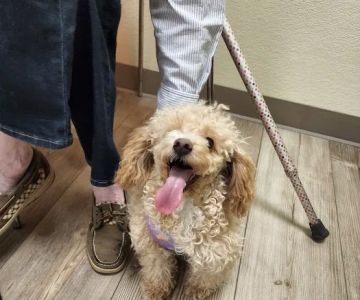Ensuring Your Pet’s Health As They Age: Tips for a Happy, Healthy Senior Pet
As a pet parent, one of the most important things we can do for our furry friends is ensure they stay healthy as they age. When I first adopted my dog, Bella, I was thrilled by how energetic and playful she was. She ran around the yard, chased squirrels, and was always up for a game of fetch. But as the years went by, I began to notice subtle changes. She started moving a little slower, was less eager to jump up onto the couch, and her playful energy began to fade. It was during this time that I realized I needed to make sure she stayed healthy as she entered her senior years. Through research, discussions with her vet, and some trial and error, I found a number of ways to help her age gracefully. Here, I’ll share the steps I took to ensure Bella's health, and how you can keep your senior pet happy and healthy too.
1. Regular Vet Checkups: Keeping Track of Their Health
The first step I took to ensure Bella stayed healthy as she aged was to establish a regular vet schedule. Just like humans, pets require regular checkups to stay on top of their health. For Bella, we started visiting the vet every six months instead of the usual once-a-year visit. Senior pets are more prone to health issues, so having more frequent vet visits allowed me to monitor any changes in her health more closely. During these visits, the vet conducted thorough exams, checked her weight, and made sure her vaccinations were up to date.
In addition to the general health checkups, I asked the vet to do more specific tests, such as blood work and kidney function tests, which are common for older pets. These tests can detect underlying issues like diabetes, liver problems, or kidney disease early on, giving us a better chance at treatment and management. The vet also recommended joint supplements for Bella, as arthritis can be a common problem in senior dogs. Getting these regular checkups has given me peace of mind and helped me stay proactive about Bella's health as she ages.
2. Proper Nutrition: The Key to Long-Term Health
Another major change I made was in Bella’s diet. When she was younger, I would buy the same standard dog food without giving it much thought. However, as she entered her senior years, I realized that her nutritional needs had changed. Senior pets have different dietary requirements compared to younger ones, so it’s crucial to feed them food specifically designed for their age group. Senior pet food is formulated with the right balance of protein, fat, and fiber to help maintain a healthy weight and prevent obesity, which is a common problem in aging pets.
Additionally, I made sure that Bella's food contained ingredients to support joint health, such as glucosamine and chondroitin. These nutrients help maintain cartilage health and reduce inflammation, which is important for senior pets dealing with arthritis or other joint issues. I also started incorporating fresh foods into her diet, like lean meats, vegetables, and fruits, to provide her with a variety of vitamins and antioxidants that can help support her immune system. By feeding her a well-balanced diet, I was able to keep her weight in check and help manage her energy levels as she grew older.
3. Exercise: Maintaining Mobility and Mental Health
Just because Bella was getting older didn’t mean she could stop exercising. In fact, regular exercise became even more important for her as she aged. I made sure to adjust her exercise routine to accommodate her changing needs, offering shorter, gentler walks instead of long runs or high-energy activities. These walks provided her with the necessary movement to maintain healthy joints, and the fresh air and outdoor exposure kept her mentally stimulated and happy.
While Bella was slowing down, I still found ways to engage her mind and body. Instead of long games of fetch, I introduced slower-paced activities like hide-and-seek with her favorite toys or scent games where she had to use her nose to find treats hidden around the house. These activities kept her mentally sharp and were a great way to bond while still respecting her physical limitations. Even small amounts of exercise help senior pets maintain muscle strength, prevent obesity, and enhance overall well-being.
4. Dental Care: A Crucial Aspect of Senior Pet Health
One area I didn't pay enough attention to when Bella was younger was her dental health. As she aged, however, I realized how important it was to care for her teeth. Pets, like humans, can develop dental issues such as gum disease, tooth decay, or bad breath as they get older. I began brushing Bella’s teeth regularly using a pet-safe toothbrush and toothpaste, which was an easy way to prevent the build-up of plaque and tartar.
In addition to brushing, I started offering dental chews to help keep her teeth clean and freshen her breath. Many senior pets are more prone to dental problems, which can lead to pain, discomfort, and even more serious health issues like heart disease. Regular dental care has helped Bella maintain a healthy mouth and avoid painful dental procedures. Keeping her teeth in good condition has played a big role in her overall health as she continues to age.
5. Comfortable Living Environment: Making Adjustments for Aging Pets
As Bella grew older, I noticed she started having difficulty with stairs and jumping onto the furniture. This is a common issue for many senior pets as their joints and muscles begin to weaken. To help her, I made a few adjustments to her living environment. First, I bought a set of pet stairs so she could easily get onto the couch without straining her joints. I also started placing orthopedic pet beds in key spots around the house, including near her favorite resting areas. These beds provided better support for her aging body and helped her sleep more comfortably.
Additionally, I kept the temperature in our home more consistent to avoid putting unnecessary stress on her body. Older pets tend to have more difficulty regulating their body temperature, so I made sure that the heating and cooling systems in our home were functioning well. Ensuring that Bella had a comfortable environment helped her feel at ease and allowed her to rest properly, which is essential for a senior pet’s health.
6. Monitoring Mental Health: Senior Pets Can Experience Cognitive Decline
Just like physical health, mental health is crucial for senior pets. I noticed that Bella started to show signs of cognitive decline as she got older. She sometimes appeared confused, had difficulty adjusting to changes in her environment, or seemed to forget her routine. This condition, known as canine cognitive dysfunction syndrome (CDS), is common in older dogs and can lead to behavioral changes such as anxiety or disorientation.
To help Bella maintain her mental health, I kept her engaged with interactive toys and puzzles that challenged her brain. I also spent more time playing with her and making sure she had enough social interaction. Regular mental stimulation can help reduce the effects of cognitive decline in senior pets. Additionally, there are supplements available, like antioxidants and omega-3 fatty acids, that can support brain health in aging pets. I worked closely with Bella’s vet to make sure we were addressing any cognitive concerns and to ensure she was as comfortable as possible in her golden years.
Ensuring that your pet stays healthy as they age is a commitment, but it’s one that pays off in spades. By staying proactive with regular vet checkups, providing proper nutrition, adjusting their exercise routine, and keeping an eye on their dental and mental health, you can help your senior pet live a long, happy, and healthy life. Bella may be slowing down, but thanks to these steps, she’s still enjoying her golden years with plenty of joy and comfort. If you’re looking for personalized advice or services for your senior pet, I highly recommend checking out the experts at Hidden Brook Veterinary, who provide tailored care and support for aging pets like Bella.











